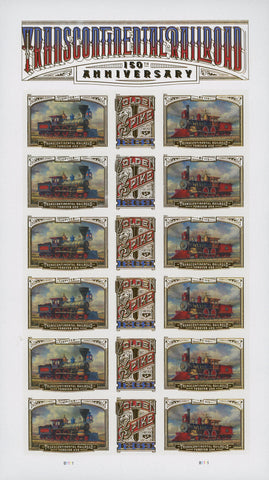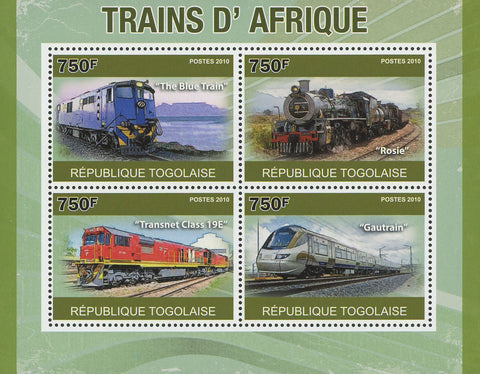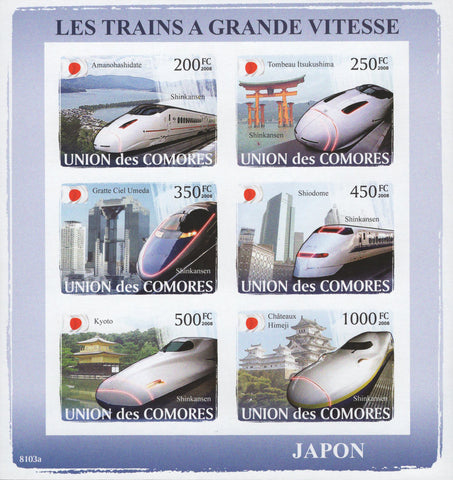Japanese Railways Train Locomotive Transportation Serie Set of 6 Stamps MNH
- Categories Trains and Locomotives, Transportation Stamps
Japanese Railways Train Locomotive Transportation Serie Set of 6 Stamps MNH
Rail transport or train transport is a means of transferring passengers and goods on wheeled vehicles running on rails, which are located on tracks. In contrast to road transport, where vehicles run on a prepared flat surface, rail vehicles (rolling stock) are directionally guided by the tracks on which they run. Tracks usually consist of steel rails, installed on ties (sleepers) set in ballast, on which the rolling stock, usually fitted with metal wheels, moves. Other variations are also possible, such as slab track. This is where the rails are fastened to a concrete foundation resting on a prepared subsurface.
Rolling stock in a rail transport system generally encounters lower frictional resistance than rubber-tired road vehicles, so passenger and freight cars (carriages and wagons) can be coupled into longer trains. The operation is carried out by a railway company, providing transport between train stations or freight customer facilities. Power is provided by locomotives which either draw electric power from a railway electrification system or produce their own power, usually by diesel engines. Most tracks are accompanied by a signalling system. Railways are a safe land transport system when compared to other forms of transport.[Nb 1] Railway transport is capable of high levels of passenger and cargo utilization and energy efficiency, but is often less flexible and more capital-intensive than road transport, when lower traffic levels are considered.
The oldest known, man/animal-hauled railways date back to the 6th century BC in Corinth, Greece. Rail transport then commenced in mid 16th century in Germany in the form of horse-powered funiculars and wagonways. Modern rail transport commenced with the British development of the steam locomotives in the early 19th century. Thus the railway system in Great Britain is the oldest in the world. Built by George Stephenson and his son Robert's company Robert Stephenson and Company, the Locomotion No. 1 is the first steam locomotive to carry passengers on a public rail line, the Stockton and Darlington Railway in 1825. George Stephenson also built the first public inter-city railway line in the world to use only the steam locomotives all the time, the Liverpool and Manchester Railway which opened in 1830. With steam engines, one could construct mainline railways, which were a key component of the Industrial Revolution. Also, railways reduced the costs of shipping, and allowed for fewer lost goods, compared with water transport, which faced occasional sinking of ships. The change from canals to railways allowed for "national markets" in which prices varied very little from city to city. The spread of the railway network and the use of railway timetables, led to the standardisation of time (railway time) in Britain based on Greenwich Mean Time. Prior to this, major towns and cities varied their local time relative to GMT. The invention and development of the railway in the United Kingdom was one of the most important technological inventions of the 19th century. The world's first underground railway, the Metropolitan Railway (part of the London Underground), opened in 1863.
Fast & Free Shipping within U.S.A.
We Care for your order, Pack it carefully and ship it within 24 hours.
Satisfaction Guaranteed!
Please explore our store for more stamps, souvenir sheets, post-office collectibles and philately books and pre-philatelic items:
montecinos.philately



















